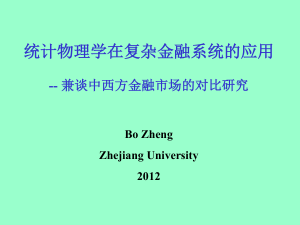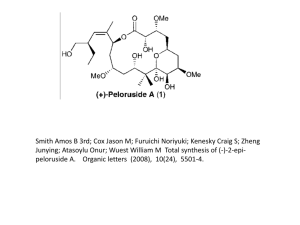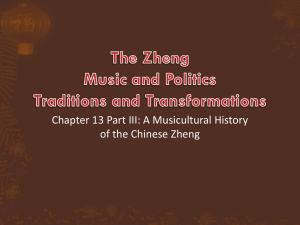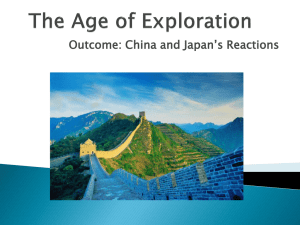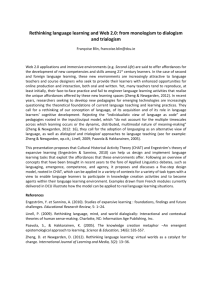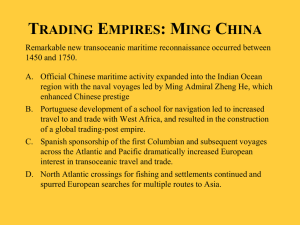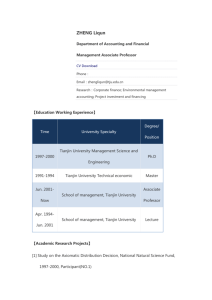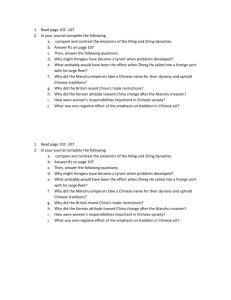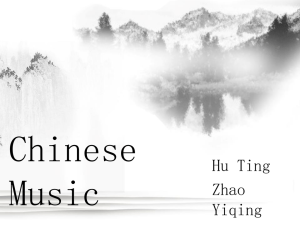Enhanced Lecture Notes - Seminar in World Music
advertisement
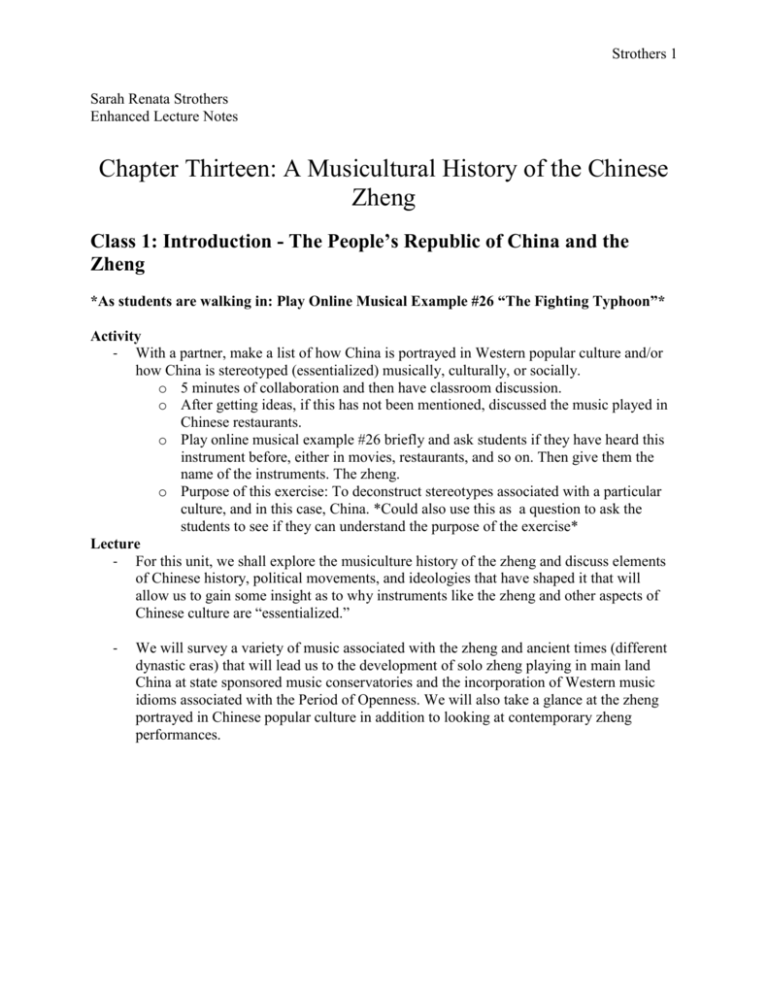
Strothers 1 Sarah Renata Strothers Enhanced Lecture Notes Chapter Thirteen: A Musicultural History of the Chinese Zheng Class 1: Introduction - The People’s Republic of China and the Zheng *As students are walking in: Play Online Musical Example #26 “The Fighting Typhoon”* Activity - With a partner, make a list of how China is portrayed in Western popular culture and/or how China is stereotyped (essentialized) musically, culturally, or socially. o 5 minutes of collaboration and then have classroom discussion. o After getting ideas, if this has not been mentioned, discussed the music played in Chinese restaurants. o Play online musical example #26 briefly and ask students if they have heard this instrument before, either in movies, restaurants, and so on. Then give them the name of the instruments. The zheng. o Purpose of this exercise: To deconstruct stereotypes associated with a particular culture, and in this case, China. *Could also use this as a question to ask the students to see if they can understand the purpose of the exercise* Lecture - For this unit, we shall explore the musiculture history of the zheng and discuss elements of Chinese history, political movements, and ideologies that have shaped it that will allow us to gain some insight as to why instruments like the zheng and other aspects of Chinese culture are “essentialized.” - We will survey a variety of music associated with the zheng and ancient times (different dynastic eras) that will lead us to the development of solo zheng playing in main land China at state sponsored music conservatories and the incorporation of Western music idioms associated with the Period of Openness. We will also take a glance at the zheng portrayed in Chinese popular culture in addition to looking at contemporary zheng performances. Strothers 2 **Show Musicultural Map** - Label the pickup truck “music” The streets “avenues” The building and swing set “culture” o We are using music as a tool to explore the avenues of culture. o If we are exploring China, what additional label can I write on the pick up truck? Zheng. People’s Republic of China - Nation-state. o What is a nation-state? (Remember from chapter 2). - Very ancient civilization. o 3500 plus years - Population of 1.3 billion o World’s largest - World’s third largest nation in geographical size o 1st Russia, 2nd Canada - Capital: Beijing (formerly called Peking) - Mandarin: Official Language o Other dialects exist: Cantonese - Han Chinese – Chinese ethnic majority. o 92% of the population - Remaining 8%, “ethnic minorities”: Tibetan, Uygur (Wee-gur), Manchu, Mongols o There are a total of 55 ethnic minority groups Major Historical Periods Discussed. - Dynastic Eras o Qin, Han, Tang, Ming, Qing - Republican period (1912-1949) o Jiang Jieshi, a.k.a., Chiang Kai-shek - Communist Period Strothers 3 - o Initial communist period, (1949-1965) Mao Zedong o Cultural Revolution, (1966-1976) Chinese communist party complete control over what music and art expressed. o Period of Openness, (1970s/1980s-present) Deng Xiaoping Throughout virtually the entire history of imperial China, music was regarded as an important component of political life. Rulers recognized, respected, and exploited what they perceived as music’s special capacity to reflect, influence, and model an idealized Chinese social order: from Confucianism to communism. Thanks China! - The Dynastic Era Invented: o Paper, wheel-carts, grid maps, accurate time-measurement devises, guns, gunpowder, and cannons. o Medical science - developed a full understanding of the body’s blood circulation system, circadian rhythms, and the dietary causes of deficiency diseases some two thousand years before such foundational features of human biology were “discovered” by Europeans. o The chromatic scale of Western music. Reportedly worked out by a Chinese music scholar using bamboo pitch pipes in the 16th century before being adopted into the mainstream of Western music during the 17th century. o Institutions such as government music ministries and state music conservatories and research institutes were also “inventions” of the ancient Chinese o More Importantly… Noodles! How did this information even get to us, and not only us, other parts of the world? - The Silk Road o Expansive trade route of antiquity that connected China to lands as distant as Central Asia, India, Egypt, and Turkey o Early form of globalization. Religions of China - Buddhism o 1st/2nd century o Ch’an-Buddhism (Zen Buddhism) Now popular in Japan o Associated with many musical styles Chanting *Play track 1, Monshogodo: Meditative Sounds of Old Japan.* Example of Buddhist chant but with shakuhachi. *Play CD EX. 3-28, Tibetan Buddhist Chant Strothers 4 - Confucianism o 1st century o Teaching of Confucius – Kong Zi *show picture* o Emphasis on social order, stressed ethical action o Qin – 7 string zither - Daoism (Taoism) o Obscure origins o Teachings of Lao Tze *show picture* o Famous Taoist text - Dao De Jing-The Way and its Power o Emphasized the virtue of Wu Wei, “non-action” Where the Confucian stressed ethical action, the Taoist spoke of the virtue of Wu Wei (non-action), going with the flow of things. Confucius and the Qin *show picture of qin and Confucius* - Corner stone of Chinese society and social policy under the rule of the Han dynasty and some of the philosophies are still influential in different aspects of today’s Chinese culture. - Confucianism insisted upon the need for social control and direction at every level. Hierarchical social stratification, deference to authority, codification of behavior across the full range of social classes, and the primacy of fulfilling one’s duty to society above all other considerations underscored its fundamental goal: the establishment preservation, and perpetuation of a morally virtuous social order. All facets of society-from family dynamics and political administration to the arts, religious belief and ritual, and cultural and intellectual life-were bound up in the Confucian code of moral virtue as “right” social order. - When properly employed, music was a medium for establishing and maintaining a good and moral society. o Cultivate inner character To mold people’s minds and hearts in ways that would make them more committed to and better capable o serving the common good - Certain types of musics for each social class. o Music is essential matching the right kinds of music with the right kinds of people. Junzi – “superior individuals” Junzi instrument – Qin - Qin o o o o o Possible ancestor to the zheng 7 string, board zither chordophone No bridges Smaller than a zheng Softer dynamic range than a zheng Strothers 5 o Instrument of the gentlemen scholar o Played solo, and in solitude Playing the qin was seen as an aid to enlightenment, disciplined thinking, and self-reflection. Many Chinese works of art and poems depict the figure of a junzi with qin engaged in quiet contemplation. Confucius himself is believed to play the qin. More on the Qin - Play CD #3-20 o Portion of a solo performance on the qin. o Melody based on an ancient Buddhist chant. o Tao Chu Sheng, Qin master from Taiwan. http://www.youtube.com/watch?v=Bv_XErQKIWY&feature=related Example of Tau Chu Sheng Note the playing techniques. Confucius Say… - Serious Quotes o “To know your faults and be able to change is the greatest virtue." o "What you do not wish for yourself, do not do to others." o "Knowledge is recognizing what you know and what you don't." - Jokes (Essentializing) o Don't drink and park - accidents cause people. o Man who sneezes without tissue takes matter in his own hands. o Wise man never play leapfrog with unicorn. Extra Credit Assignment - Find an instrument or music genre within this chapter that isn’t thoroughly discussed in class. o Xiao, pipa, Beijing Opera – These are just examples. o Anything but the Zheng or Qin. o E-mail me your topic. o Create a five minute power point presentation and teach this instrument/music to the class. o Proposals due Tuesday October 25th - Since the book mainly focuses on the zheng, this is a good opportunity for you to explore the other instruments and musical genres that are in China. There are quite a few instruments/genres Next Class - Histories linked with the zheng - It’s evolution in the different dynastic eras - Role of Woman - Different regional styles Strothers 6 Class 2: The Zheng and its Histories *As students are walking in: Play Online Musical Example #3-23 “Autumn Moon over the Han Palace”* The Zheng - Chinese board zither chordophone - Zither: any type of musical stringed instrument with a construction that features a series of strings laid lengthwise across a wooden frame. - Ancestor is the Qin. 7 string zither. Invented more than 2,500 years ago. - Construction: Wooden frame, 16-21 strings nylon/steel strings. - Strings are supported by movable bridges. o The qin does not have movable bridges. - Positioning of the bridges is adjusted for different tunings. - Similar instruments: Japanese koto, Vietnamese dan tranh, Mongolian jatag, Korean kayagum. Deng Haiqiong - Teaches Chinese Ensemble at FSU o http://www.youtube.com/watch?v=KDyKe7lbgZ0&feature=&p=404288924BBF F62B&index=0&playnext=1 - Leading zheng player of her generation - Born: 1975, started playing at the age of 8. - Shangai conservatory of Music. - 1995: 1st prize in National Zheng Competition of China - Concertized in China, Japan, Singapore, and U.S. o New York’s Carnegie Hall - Studied ethnomusicology Activity: Play Musical Guided Tour, Page 297 - Have students follow along in their books. Highlight important phrases on the power point. o Range of 4 octaves for 21 stringed zheng o Range of 3 octaves for 16 stringed zheng o Alter the positions of the movable bridges on the instrument allows for several different pentatonic tunings. o Traditional playing style: The right hand is only used. o Since 1950’s, both hands have been incorporated. o Techniques reflect Western musical influences – especially from piano music. o Uses highly developed melodic ornamentation such as: Yao zhi – tremelo/roll Da Yau zhi - faster tremelo/roll (a quicker motion back and forth) “Four-point fingering technique” – alteration of middle, thumb, and index finger Strothers 7 Gua-zou or glissando Narrow or wide vibratos Tremelos/rolls Harmonics Theories of Origin - Theory 1: o Onomatopoeic: Reflecting the timbre of the instrument when it’s plucked. - Theory 2: o Due to its translation: “Dispute.” Involved an argument between sisters during the Qin dynasty - (Qin dynasty) – Legend has it that during the ancient era of the Qin dynasty two sisters in the imperial palace got into a heated argument over a 25 string se zither and broke the instrument in half. This yielded two instruments, one with 12 strings, the other with 13. Amused by the incident, the emperor named these new “half” instruments “zheng” in acknowledgement of the “dispute” that have given rise to them. According to some versions of the story, the 13 string instrument was eventually given as a gift by the Qin emperor to the imperial house of Japan, giving rise to the 13 string koto. The 12 string model, meanwhile, ended up in Korea, where it became the prototype of the 12 string Korean kayagum. - Unknown origins: o Earliest documentation of the zheng found in Qin era manuscripts, referring to musicians that: “Beat clay drums and earthen jars, play zheng and slap their thigh to accompany songs.” - Zheng’s rise in popularity due to: o Loud, portable, and adaptable to musical situations. o Geographical and musical diffusion Advent of the first “popular” music in China Zheng in the Han Dynasty (202 BCE – 220 BCE) - Confucianism established as the foundation of Chinese social action. - Emphasis on ethical behavior and fulfilling your role in society - Zheng: instrument of entertainment, public ritual, and self cultivation. o Weddings, banquets, funerals, and accompany elaborate entertainments that involved singing, acrobatics, and dance. So depending on your class, it would dictate how the instrument is used. - Played by professional court musicians, woman, slaves, and commoners. - Some considered it a vulgar instrument, while others hailed it as a tool to embody high moral character. If you were of high social status you may thought the instrument vulgar if you saw someone of low social status playing it. The Zheng and the Tang Dynasy (618-907 CE) - The zheng reached musical heights. - Music ministry program that employed 30,000 musicians and dancers. - Musical experimentations with the Zheng: Strothers 8 - - - o Ensembles Pipa (pear shaped lute), Xiao (flute), Erhu (fiddle) Play CD #3-21 Duet for zheng and pipa o Pipa looks like what type of instrument? Play CD # 3-22 Zheng, pipa, xiao, and pipa http://www.youtube.com/watch?v=jo43B8rYVQ0&feature=related o A modern example of traditional Chinese instruments playing together. New features added to the Zheng o More strings o New playing techniques introduced o Earliest examples of Zheng music notation Rise of women playing the zheng o Previous eras, usually of low status. o Became popular with women of high social status A woman playing the zheng became a romanticized image and associated with romantic subjects. o The beauty of nature, the beauty of women, sentimental feelings of love, memories of sadness and longing. Emperor Xuanzong *Show picture of him (google images)* o Played an integral role in cultivating the zheng as a “women’s instrument.” o Promoted women’s performances: o Hired musicians to train women how to play. o These women would entertain imperial guests at banquets. o Improved the overall social status of musicians. The Zheng and the Ming Dynasty (1368-1644) - Rise of the middle class - Zheng became a “household” item - Girls and young women were especially encouraged to study and play the instrument. - Regional styles of Chinese opera: - Xi, Xiqu, Xiju: Zheng important accompaniment instrument. o “Distinctive zheng playing techniques and styles of melodic ornamentation were developed in each region to capture nuances of regional languages and dialects, especially in connection with local types of opera, song, and their related instrument musical styles” (Bakan, 304). Read Insight and Perspectives – Chinese Opera and Beijing Opera in Dynastic and Post-Dynastic China as a class. - This era heavily important to the emergence of regional styles of solo zheng playing. The Zheng and the Qing Dynasty (1644-1911) - Distinct regional styles of zheng playing have crystallized: - Developed out of existing regional traditions of folk opera, sung poetry, musically accompanied storytelling, and instrument ensemble music involving the zheng: they also reflected a long history of mixing between folk, popular, and court music traditions. Strothers 9 - - o Shandong, Henan, Shaanxi, Chaozhou, Hakka, and Zhejiang all had different characteristics of playing styles. *Show map of the different regions (google images)* These regional styles exist today, though, in many respects, they have been absorbed into the “national” style of the conservatories. Regional styles gave rise to traditional solo zheng Music Common to the various regional styles is the baban: o Traditional Chinese melodic form with 8 main melodic phrases. Each regional style has its own distinctive yun or regional character. o For example: The yun of the Henan zheng is known for its liveliness and short descending melodic phrases. Each regional style (including the bulk of all traditional Chinese music) is associated with a specific yijing: o Designated emotional quality of a musical work. Usually complex and multifaceted rather than simple and straightforward. Example of regional style o “Autumn Moon Over the Han Palace” o Performer: Deng Haiqiong CD #3-23 o Representative of Shandong regional zheng style o Played on a 16 string zheng with steel strings. Smaller zheng is preferred for traditional pieces. o Yijing: “Sadness.” “The yijing of a sadness that’s in your heart, that you keep inside yourself…It’s very gentle, moderate, and controlled. This sense of moderation is what has to come through when you play the piece. More important than expressing ‘sadness’ through the music for me is expressing this mood of moderation, of a certain sense of peacefulness and restraint” (Bakan, 306 – Deng Haiqiong). Activity: Guided Listening Page 307, Play CD-23 “Autumn Moon over the Han Palace.” - Have students listen to the track and follow along with the guided listening. o Point out the different playing techniques. o Possibly have them raise their hand when they hear a glissando, up-glide, downglide, and etc in Phrases 2-8 to engage “active” listening. Next Class - Conservatory Solo Zheng style o Communist China o Cultural Revolution Era o Period of Openness - Zheng in musicultural life post-1970s o Crouching Tiger Hidden Dragon - Zheng in popular culture o Kung Fu Hustle Strothers 10 Class 3: The Zheng - Music and Politics Traditions and Transformations *Play ”Return of the Fishing Boats,” By Lou Shuhua CD EX. 3-25 as students walk into the class” Emergence of Conservatory Solo Zheng Style - Republic Era (1912-1949) o Political instability and massive cultural reform o Appropriating Western technological, economic, and cultural systems o Chinese traditional musics seen as regressive. Wholesale replacement of Chinese music with Western music. o Western music was prized as an adopted icon of Chinese modernity “Race towards modernization” o Attitude: Prevalent notion that Western music was superior. o Ethnomusicologist Stephen Jones: “Students of traditional Chinese instruments are plainly considered inferior to students of Western music…For many urban Chinese, their traditional music is ‘backward,’ less ‘scientific,’ than Western music.” o Many schools/conservatories were devoted to the cultivation of Western music instead of Chinese music. Total adoption of Western music conservatory system. Republic Era: Different School of Thought - Liu Tianhua (Lee-oo Tee-en hwah) o Chinese composer and musician o Argument: Traditional musics and instruments should not be discarded, but reformed and modernized. o Incorporating Western elements o Collecting, transcribing, and publishing traditional folk music from different regions of China and rearranging it sound more “current.” Folk music was used to provide a base upon which a new Chinese national music would be created with the aid of more “advanced” musical resources. o This was to be a music imbued with Chinese “national characteristics,” fused with elements of Western music so that it can be “the equal of Western music.” Regional zheng musics still existed-but at local musicultural scenes. o New pieces based on traditional tunes and forms modified in ways that reflected new musical values and approaches. “Return of the Fishing Boats” by Lou Shuhua - Broke away from baban form o What number is associated with baban? o Baban form is associated with what type of Zheng music? - Use of more ornamentation o guo-zou – glissandos Strothers 11 - - Programmatic effect o Evoke the motion and sound of the fishing boats Fishermen rowing faster and faster returning from work at the end of day. o Common feature in most Chinese music; however, more emphasis was placed on the programmatic concept during the Republic era. Overall: More ornamentation, new techniques being employed, fluctuating tempos for dramatic effect, and wide dynamic ranges are being used to “paint” a musical image. Activity – Programmatic Effect For Each musical example, write down the “images” you see. - Play excerpt: Peer Gynt - Morning - Play excerpt: Peer Gynt - In the Hall of the Mountain King - Play excerpt: “The Sorcerer’s Apprentice” - Play excerpt: “Night On Bald Mountain” o Once everyone is finished, discuss answers and what picture/story each composer was trying to convey – emphasizing the notion of programmatic effect. If there is time, play an excerpt from Disney’s Fantasia - http://www.youtube.com/watch?v=XChxLGnIwCU The Sorcerer’s Apprentice Activity: Guided Listening “Return of the Fishing Boats” Page 309 - Excerpt 1. Opening section of the piece Play (CD EX. #3-24) o Traditional musical style similar to that of baban-form pieces, slow tempo, conventional ornaments, single-line melody, relaxed and contemplative mood. - Excerpt 2. Closing Section of the Piece (CD EX. #3-25) - What are some elements that are different? o Departure from traditional zheng musical style on multiple levels: Form no longer present Elaborate use of gua-zou (glissando) ornamentation Dramatic use of dynamics, tempo, and the explicit programmaticism of the music If we can remember from the last slide, what image is this particular piece painting? Question for everyone but geared towards my music majors: Where else in music history do we see the use of programmaticism? o Do you think that this composer was influenced by that type of programmaticism? o Why? (Reflective of Western music aesthetic.) Conservatory Solo Zheng Tradition in Communist China (1949-1965) - Mao Zedong (show picture of Mao from google images) o Chinese Communist Party (CCP) o Gained political control of China in 1949 o Chinese socialism: Importance of state patronage Strothers 12 - - Paying homage to Mao Zedong o Control of music in efforts to encode and promote state ideology o Musical propaganda o Heavily regulated through national music conservatories and music research institutes. Making sure it is in tune with state ideology Music/Arts were to expressively serve the goals of the socialist state. o Show picture of Mao Zedong as “the never setting sun.” (Google images). Under Mao’s rule, the government gradually became the sole official patron and controller of the arts, artistic activities, and arts-related institutions in Communist China. o Elevate and valorize the working class o Promote revolutionary ideas (approved…) o Glorify the revolution, communism, and Mao himself. Communist songs for the masses were created in abundance and used to propagate Chinese state ideology and policies. Regional and national music conservatories and research institutes played a major role in cultivating and promoting the new, official, musical culture of the Chinese communist state. Western music and instruments (especially violin and piano) continued to have the highest prestige, but Chinese music and instruments, including the zheng, made gradual advances in prominence and stature. The first full-fledged Chinese conservatory curriculum in zheng was established at Shenyang Conservatory in 1950. Activity – Listening: “On the Golden Hill of Beijing” CD Ex. #3-26 - Sung by Deng Haiqiong’s Mother, Li Xiuqin with zheng accompaniment by Haiqiong. o Melody is a Tibetan folksong This is foreshadowing a bit, but why do you think a Tibetan folksong was being used? o Invokes several standard themes of Chinese communist rhetoric: The literal and metaphorical glorification of Mao Zedong and the CCP The rationalization of CCP policies regarding China’s “ethnic minorities” The “emancipation” of the peasant masses The ideal of building socialism for China o Have a student read the lyrics out loud. o This listening is evidence of the zheng rising in stature: It is used as accompaniment instrument during a time where traditional Chinese music was thought of as regressive. What other instruments could have been used? Done so strategically because the CCP occupied Tibet and the Tibetan people were severely oppressed. o This listening also shows how the Chinese Communist Party was using music to persuade the masses that their political agenda was the “right” agenda. Activity (If there is time) Watch an excerpt from: - http://www.youtube.com/watch?v=fTY5aZuO_bc "The East is Red" Strothers 13 o Film musical of the 1960s, depicting the spirit of Communist China and Maoist Revolution—note giant orchestra with massive erhu section AND violin section, massive choir, big dance production number. All of these things emulating Western aesthetics while incorporating the socialist agenda and traditional instruments. Zheng: The “Genuine” Folk Instrument - Within the new socialist musical environment of the urban conservatories and music institutes, the zheng was promoted as a “genuine folk instrument” and many new works for solo zheng were composed. o “Return of the Fishing Boats.” - Additionally, these pieces were linked to titles and “programs” – descriptions of what the music was properly supposed to represent and evoke o Not to be confused with programmatic effect. The program in this sense, although similar to the programmatic effect serves two purposes: 1) Promote the socialist agenda by making it clear what this particular zheng piece is for and 2) Have the music reflect the political character of the socialist agenda. “Little Sister Hero of the Plains” – Dramatically depicts a Mongolian child protecting her commune’s sheep in the midst of a blizzard while singing songs in praise of the Cultural Revolution. - 1958: Government initiative to increase the official stature of Chinese music led several talented pianists to switch to the zheng as their main instrument. o Fan Shang’e - The virtuosic, “pianistic” potential of the zheng was greatly developed by this new generation of performers. - Pieces became technically demanding o 16 string zheng expanded to the 21 string zheng Activity Guided Listening - “Spring on Snow Mountains” by Fan Shang’e CD. #3-27, Page 313. - Tibetan folksong is the melody but the piece has little to do with traditional Tibetan folk music. - Socialist program: Describes a scene of Tibetans happily singing and dancing in their beautiful, mountainous land in a spirit of welcome toward Chinese communist rule. o Highly developed two-hand playing technique. o Two-part texture. RH melody [tremolo sustain], LH arpeggiated chords (Western piano/harp influence) with abundant glissandos (ornamentation). - 1:02-End o First portion of concluding section of piece, in which the melody and lively rhythm are intended to evoke an image of “happy Tibetans” performing folk dances. Cultural Revolution Era - Official musical life very constrained. o In the opera world, a total of only eight government-approve “revolutionary dramas” of especially strong socialist ideological content Strothers 14 - - Revisit Insights and Perspectives: Chinese Opera and Beijing Opera in Dynastic and Post-Dynastic China Development of zheng stifled during this oppressive period, new pieces that emerge exceedingly ideological. o Example: Little Sister Hero of the Plains” which depicts a Mongolian child protecting her commune’s sheep in the midst of a blizzard while singing songs in praise of the Cultural Revolution. o Example: “Molten Iron Pouring in a Stream” Freedom of artistic and intellectual expression severely constrained. o Brutally oppressive policies If you didn’t follow the rules, you were sent to a work camp. Brutal persecution of minorities, people who practiced religion, intellectuals, etc. Period of Openness (1970s to Present) - Death of Mao Zedong 1976 o End of the Cultural Revolution - Deng Xiaoping reemerged as the new leader, initiation the “Period of Openness” o Good things: New Policy for the Arts Have a student read quote page 316. o Political experimentation: Maintain the socialist agenda but with free enterprise, openness to international markets, cultural openness (as we have read in the quote), acceptance of formerly condemned Western musical forms, but the authoritative “iron fist” rule still implemented. o Bad things: Tiananmen Square Massacre of 1989 Read Insights and Perspectives Cui Jian and the Tiananmen Square Uprisings as a Class - Other musical/cultural results o Zheng musical renaissance Development of the Beijing Zheng Association in 1980 Revival of older regional styles More Female dominance New instruments developments 49-string “Butterfly Zheng” o Revival of Traditional Beijing Opera o More international recordings o “New Wave” movement in modern Chinese music Tan Dun “Desert Capriccio” from Crouching Tiger Hidden Dragon Play CD Ex. #3-29 Play Youtube Clip of the movie http://www.youtube.com/watch?v=hOlA6LLATuY&feature=r elated o Have the students raise their hand if they can hear a portion of “Desert Capriccio.” o Numerous leading conservatory-trained zheng players establish international careers: Deng Haiqiong. Strothers 15 An Additional Bad Thing: Continued Cultural Appropriation - A significant portion of the repertoire of solo instrumental music of the modern conservatory zheng tradition consists of syncretized Western/Chinese compositions “based on” minority music traditions of people such as the Uighurs and Tibetans. o Is this problematic? o Is this still invoking a socialist program? - “The people ostensibly represented through music of this kind-Uighurs, Tibetans, members of other minority groups in China-typically resent having their musical traditions, and by extension themselves, cast in this light.” (Bakan, 315). Activity: Guided Listening – “Music from the Muqam,” CD EX. #3-30 by Zhou Ji, Shao Guangchen, and Li Mei - Have students follow along on page 321. - Composition with zheng and drum accompaniment. o Dap drum (donkey/snake skin head) - Formally and stylistically, draws from tradition of Uighur muqam o Dolan Muqam. o Muqam is similar to what word in chapter 12? A large-scale pre-composed suite of songs and instrumental music Word related to Arabic maqam, but the meaning is different. May be vocal or instrumental, chamber or larger ensemble - The scale utilized in the zheng part is unconventional for the instrument. o It reproduces the common Uighur mode. What is a mode? - “Uighur” elements (cultural appropriation) Part I of Excerpt: Pitch bend ornament Part II of Excerpt: Aksak rhythms/meters Meters of five and seven are common in Uighr music, where they generate what the Uighur fere to as aksak, literally “limping” rhythms. - Read Insights and Perspectives Uighur History and Culture as a Class Activity: Watch an Excerpt of Kung Fu Hustle - An example of the Zheng portrayed in Chinese popular culture. o http://www.youtube.com/watch?v=wVjf5CccAwY - Answer the following questions: o What are some of the “traditional” aspects of the zheng performance that are being portrayed? o What are some of the “nontraditional” or “fantasy” aspects that are being portrayed in regard to the zheng performance and the music in the movie?
